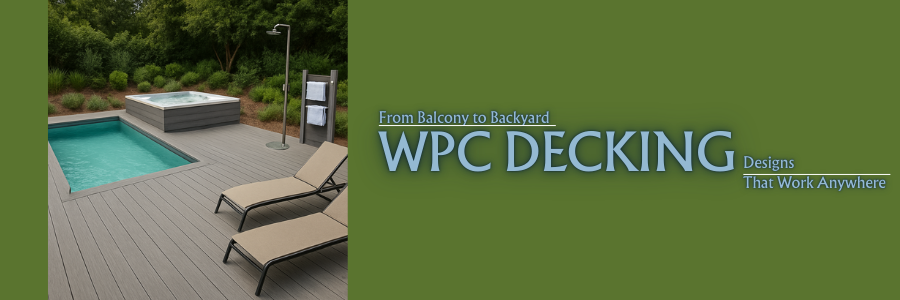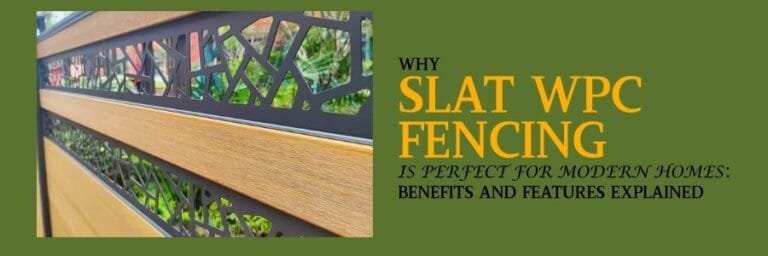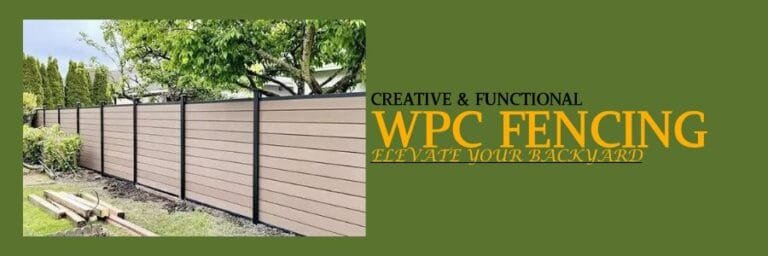Looking to upgrade your space with a deck that’s beautiful, strong, and easy to maintain? Whether you have a small balcony or a big backyard, WPC decking could be the perfect solution.
WPC stands for Wood-Plastic Composite, a smart mix of recycled wood fibers and plastic that creates boards that look like wood but last much longer. These boards don’t rot, splinter, or fade easily, making them ideal for both indoor and outdoor spaces.
From cozy urban balconies to wide garden patios, WPC decking is flexible enough to fit anywhere. In this guide, we’ll show you how you can design with WPC decking in different settings, and why it’s becoming a favorite choice for modern homeowners and builders.
Whether you’re after a sleek, modern look or a warm, wood-style finish, you’ll find that WPC makes designing outdoor living spaces simpler, cleaner, and much more enjoyable.
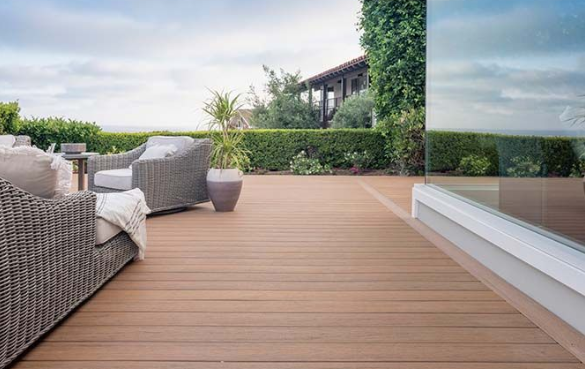
Why Great Decking Design Starts with the Right Material?
Creating a beautiful outdoor space begins with one important choice: the right decking material.
Whether you’re designing a small balcony or a large backyard patio, the material you choose affects not just the look, but also how long your deck lasts, and how much effort it takes to maintain.
Let’s explore why WPC decking is one of the best choices for modern outdoor living, and how KR WPC helps bring your design ideas to life.
The Role of Decking in Modern Outdoor Living
Today, outdoor spaces are more than just open areas, they’re extensions of our homes. A well-designed deck can turn a simple backyard into:
- A cozy lounge area with outdoor seating
- A dining space for weekend BBQs
- A play zone for kids
- A quiet spot for morning coffee on the balcony
Decking helps define these spaces. It creates a clean, level surface that’s safe, stylish, and easy to care for. And because it’s the foundation of your outdoor setup, choosing a strong and good-looking material is key.
Benefits of Choosing WPC for Deck Design
WPC (Wood-Plastic Composite) is made by mixing recycled wood fibers with plastic. This creates a material that looks like wood but is much more durable.
Here’s why WPC is a smart choice:
- Durable: WPC doesn’t crack, warp, or splinter like regular wood. It’s built to handle daily use, weather changes, and heavy foot traffic.
- Water-resistant: Unlike wood, WPC doesn’t absorb water. That means no swelling, rotting, or mold, even in rainy or humid areas.
- UV-stable: The color of WPC decking doesn’t fade easily in sunlight. You won’t need to paint or stain it every year.
- Eco-friendly: Made from recycled wood and plastic, WPC reduces waste and helps protect natural forests.
- Low maintenance: No need for sanding, sealing, or repainting. Just occasional cleaning with water keeps it looking new.
Example: If you have a balcony exposed to sun and rain, WPC decking can handle the weather while keeping its color and shape. If you’re building a pool deck, WPC is a safe, water-resistant surface that won’t get slippery or rot over time.
The KR WPC Advantage
When you choose KR WPC, you’re getting more than just a decking board, you’re choosing expert craftsmanship and dependable quality.
Here’s what sets KR WPC apart:
- Aesthetic options: Choose from a wide range of colors, textures, and finishes, from natural woodgrain to modern matte surfaces. KR WPC regularly updates its styles to match the latest design trends.
- Structural integrity: Each board is made with precision molds and high-density materials to ensure strength and consistency. You can use them for everything from balconies and patios to rooftop decks and garden walkways.
- Long-lasting performance: KR WPC products are tested for fire resistance, UV protection, and load-bearing capacity. They’re built to last for 15–25 years, even in tough outdoor environments.
Whether you’re designing a quiet personal retreat or a busy family gathering space, KR WPC decking offers the beauty of wood, with none of the problems.
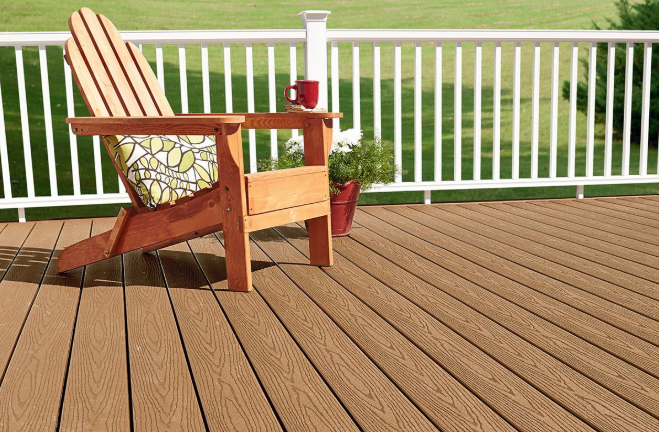
Creative Decking Ideas for Different Spaces
WPC decking offers more than just durability, it opens up a wide range of design possibilities for both small and large spaces.
Whether you’re working with a tight urban balcony or a large sloped yard, the right design choices can transform ordinary areas into functional, beautiful outdoor living zones.
Compact Gardens: Make Every Square Meter Count
Small gardens don’t need to feel cramped. With the right decking plan, even the tiniest courtyard or backyard can be turned into a relaxing and functional space. WPC boards are ideal here because they are easy to cut and install, and they require very little maintenance.
Design suggestions:
- Built-in seating: Instead of buying furniture, incorporate seating into the decking itself. A corner bench made from the same WPC boards can free up space and provide a clean, modern look.
- Integrated planters: Add raised planter boxes along the edge of the deck using the same material. This keeps the design consistent and allows for a mix of greenery and hardscape.
- Multi-level platforms: If space allows, use two or three slightly different levels to divide your garden into zones, for example, a lower area for lounging and a raised platform for potted plants or a bistro set.
Visual Example:
A 3×4 meter backyard is fully decked in light brown WPC, with a built-in L-shaped bench in one corner, a vertical wall garden against the fence, and a raised planter with herbs along one side.
Elevated Decks for Sloped Yards
Yards with uneven or sloped ground can be challenging to use effectively. An elevated WPC deck provides a level surface while making the most of the landscape.
Design advantages:
- Raised decks help level out bumpy or sloping terrain, making the space more usable.
- A platform deck can be built with steps, railings, and even under-deck storage areas.
- WPC is structurally strong and resists water damage, making it ideal for long-term outdoor installations.
A backyard with a gentle downward slope features a two-tiered WPC deck: the top level has a dining table and chairs under a pergola, and the lower level has lounge chairs and a fire pit area, surrounded by native plants.
Poolside or Hot Tub Decking
Areas around pools and hot tubs require materials that can handle constant moisture. WPC is an excellent choice because it doesn’t absorb water, doesn’t splinter, and offers textured finishes for added safety.
Safety and style features:
- Choose WPC boards with a grooved or embossed surface to reduce the risk of slipping.
- Lighter colors help keep the surface cooler under direct sun.
- WPC doesn’t warp or rot, even with heavy splashing or constant exposure to water.
A backyard pool area is framed with wide, grey-toned WPC decking. The surface wraps around the entire pool, with a raised platform holding the hot tub. Lounge chairs, an outdoor shower, and built-in towel racks are placed directly on the deck for a clean, unified design.
Rooftop or Balcony Decking
Urban rooftops and apartment balconies are often overlooked, but with WPC decking, they can be turned into stylish and comfortable outdoor rooms. WPC is lightweight compared to traditional wood or stone, making it suitable for elevated structures.
Why WPC works well here:
- Easy-to-install interlocking tiles are ideal for balconies and rooftops, especially where structural weight is a concern.
- The boards are resistant to wind, rain, and sun, requiring minimal upkeep.
- Matching privacy screens or divider panels can be made from the same material for a cohesive look.
A city rooftop is transformed into a contemporary lounge using light grey WPC tiles. A modular outdoor sofa sits along the edge, with tall potted plants for privacy. Overhead string lights and a small grill area complete the space without adding too much weight.
Seamless Indoor-Outdoor Transitions
When the same material is used both indoors and outdoors, or when finishes are matched closely, it creates a feeling of flow. This design technique is especially useful in smaller homes, where extending the look of interior flooring into the patio or garden helps visually expand the space.
Design tips for continuity:
- Select WPC decking that mimics the tone and texture of your indoor flooring.
- Install the planks in the same direction as the indoor floorboards.
- Use large sliding doors or foldable glass panels to physically and visually connect the two spaces.
A home with warm-toned oak flooring extends the same tone into the backyard using WPC decking in a similar finish. The outdoor area mirrors the living room’s furniture, featuring matching neutral cushions and side tables, creating a seamless transition between indoor and outdoor spaces.
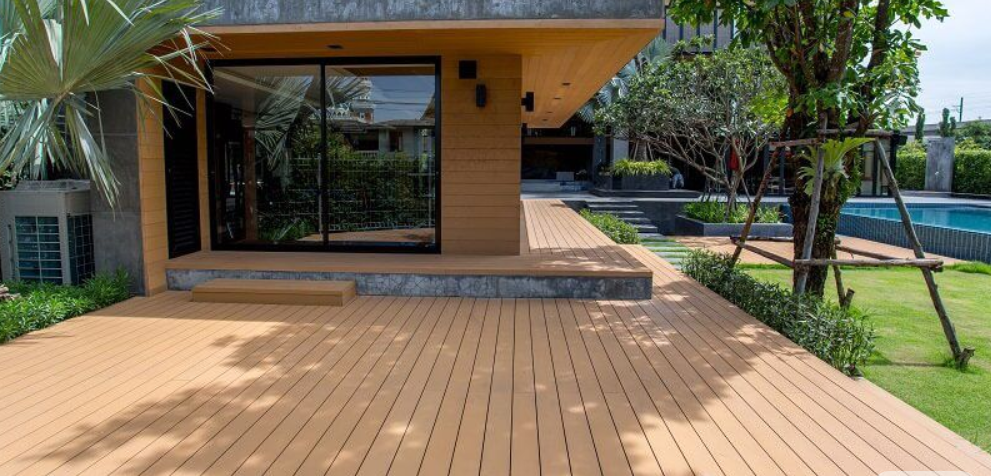
Decking Layout & Design Tips
Designing your WPC decking layout isn’t just about placing boards, it’s about creating a visually appealing, functional space that enhances the entire outdoor environment.
The way you lay your boards, combine materials, and coordinate colors can make even the simplest space look polished and well thought-out.
Below are practical and creative design tips that work across balconies, backyards, gardens, rooftops, and more.
Playing with Plank Direction and Patterns
The direction and pattern of your decking boards can completely change the look and feel of a space. Instead of laying planks in a straight, horizontal direction, try experimenting with visual patterns that add movement and interest.
Popular options include:
- Diagonal Layout: Laying the boards at a 45-degree angle can make a narrow space feel wider or more dynamic.
- Chevron Pattern: Boards are cut at an angle and joined in a V-shape, creating a sleek, modern design.
- Herringbone Pattern: A classic style where planks meet in a staggered zigzag pattern, often used in high-end interiors and now extended outdoors.
- Picture Frame Borders: Placing a border of horizontal or vertical planks around the main field adds a finished, framed look and helps define the edges.
A small patio deck with a central chevron pattern and a darker-colored picture frame border draws attention to the middle of the space and feels more custom-designed than a standard layout.
Mixing Materials for Contrast
WPC decking works beautifully on its own, but combining it with other materials can add contrast and texture, creating a more layered and designer-like finish.
Materials that pair well with WPC:
- Stone or pavers: Use stone pathways or tile accents inlaid within the decking to break up large surfaces.
- Glass railings: These keep sightlines open while adding a clean, contemporary touch.
- Greenery: Integrate planter boxes, vertical gardens, or turf strips to soften the space and bring in natural elements.
A rooftop deck features grey WPC boards with black stone paver steps leading to a raised lounge area. Along the edge, built-in planters filled with ornamental grasses help soften the lines and add movement.
Lighting Integration
Adding lighting to your WPC deck not only improves safety but also enhances ambiance, especially in the evenings. Deck lighting highlights key areas, defines walkways, and sets the mood.
Options to consider:
- Recessed spotlights: Installed between boards or in steps to light paths and edges without being obtrusive.
- Deck-edge LEDs: Mounted along the outer edge of the deck to create a glowing border effect.
- Solar path lights: Easy to install and energy-efficient, these work well along walkways or around garden zones.
A backyard deck with warm white LEDs under the stair treads and subtle uplighting in planter boxes creates a cozy, inviting atmosphere for outdoor dinners and evening relaxation.
Color Coordination
Choosing the right deck color and coordinating it with the surroundings is key to creating a cohesive design. WPC decking comes in a variety of shades and finishes, from natural wood tones to sleek greys and rich browns.
Tips for coordination:
- Match or complement your home’s exterior walls or trim for a unified look.
- Pair with outdoor furniture that shares similar tones or materials.
- Coordinate with fencing, pergolas, or planters made of matching WPC or neutral colors.
A tan-colored WPC deck pairs with a white stucco wall and beige outdoor furniture for a warm, beach-inspired aesthetic. Matching tan fencing panels tie everything together without overwhelming the space.
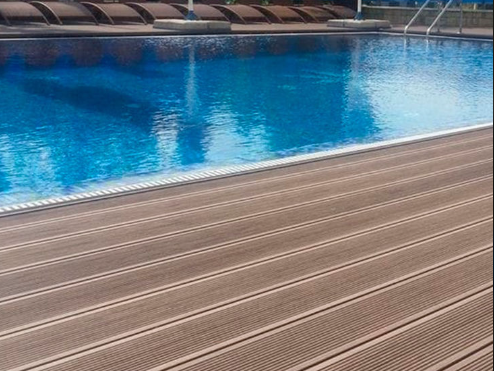
Making It Functional: Add-Ons That Matter
A great deck isn’t just about surface space, it’s about how you use it. Functional add-ons can turn a basic WPC deck into a practical, comfortable, and beautifully organized outdoor living area. Whether you’re working with a small balcony or a spacious backyard, these upgrades can help you make the most of every square meter.
Built-in Storage or Benches
For compact decks, space is often limited. Built-in seating and storage help keep the area tidy while maximizing usability.
Why it works:
- Benches built directly into the edge of the deck save space and reduce clutter.
- Storage compartments beneath seats are ideal for keeping outdoor cushions, tools, or toys neatly tucked away.
- Using the same WPC material creates a uniform, polished look.
A 3×3 meter patio includes an L-shaped bench in one corner, with hinged lids that lift to reveal hidden storage. The clean design eliminates the need for bulky furniture and keeps everything within reach.
Pergolas and Shade Structures
Adding shade is not only practical, it adds character and comfort. A pergola or overhead cover creates a more livable space by offering relief from direct sunlight and defining the deck as its own outdoor “room.”
Benefits:
- Provides protection during hot weather or light rain.
- Offers a structure for hanging lights, curtains, or plants.
- Increases privacy without enclosing the space.
A backyard deck features a WPC pergola in a matching grey tone, with fabric drapes on the sides and climbing vines growing up one post. This adds charm, softness, and shade, ideal for dining or lounging.
Railings and Borders
Borders and railings help define the edges of your deck while adding a layer of safety and visual interest, especially on raised or rooftop decks.
Design options:
- WPC fencing panels can be used as deck borders, giving a clean, coordinated look.
- Glass railings maintain visibility while adding a sleek, modern feel.
- Contrasting border planks help frame the deck and visually separate zones.
An elevated terrace deck features clear glass railings for an unobstructed view, with darker WPC boards framing the perimeter to distinguish the lounge area from the walking path.
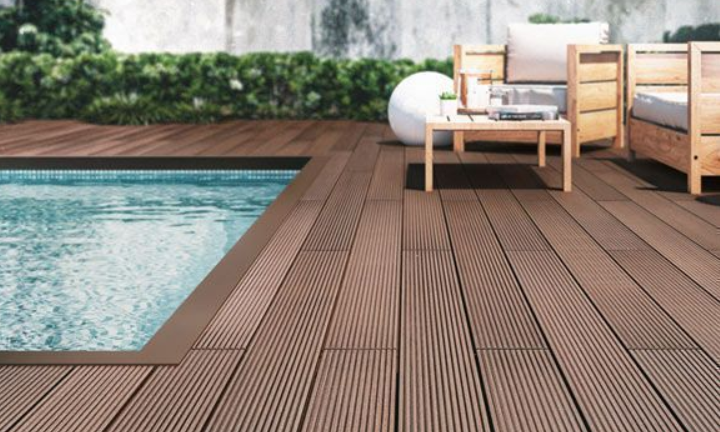
Design Considerations Before You Build
Before installing WPC decking, it’s important to plan carefully. Good design doesn’t start with what’s on the surface, it starts underneath. Considering factors like structural support, airflow, and environmental conditions ensures your deck lasts longer, performs better, and stays beautiful with less maintenance.
Load-Bearing and Framing Essentials
WPC decking needs a strong foundation. Even though WPC is durable and low-maintenance, it still depends on proper framing for safety, stability, and comfort.
Joist spacing is critical. For most WPC boards, the joists (the horizontal support beams beneath the decking) should be spaced no more than 300 mm (about 12 inches) apart for solid boards, and 250 mm (10 inches) for hollow ones.
Use corrosion-resistant fasteners and properly treated substructures to prevent long-term wear.
Drainage and Airflow
WPC decking is naturally resistant to moisture, but to ensure long-term durability, it’s important to manage water drainage and promote airflow beneath the deck. While the boards themselves won’t easily warp or rot, the structure underneath can still be affected by trapped moisture if it’s not designed properly.
To prevent this, always leave small gaps, typically around 5 to 6 millimeters, between each deck board.
These gaps allow rainwater to flow through instead of pooling on the surface. It’s also essential not to seal off the bottom of the deck completely. Ventilation is critical, as it allows air to circulate and helps moisture evaporate more quickly from the substructure.
If you’re building over concrete or on a balcony where water has nowhere to drain naturally, consider using adjustable deck pedestals. These elevate the decking slightly, creating a slope (about 2%) that encourages water to move away from the structure.
For example, a ground-level patio deck designed with a gentle slope and uniform spacing between each board allows water to run off easily. The edges are left open or vented, which helps air move underneath the deck, keeping it dry and reducing the risk of mold or mildew forming over time.
Local Climate and Sun Exposure
Your local environment can influence the performance and appearance of WPC decking. Choosing the right color and finish based on your climate helps maintain the look and feel of your deck over time.
In hot, sunny climates, choose lighter-colored boards like beige or light grey. These reflect heat and stay cooler to the touch.
For colder or damp climates, choose darker tones that absorb sunlight and dry faster. Also, look for boards with anti-slip surfaces.
UV-stable coatings help prevent fading in areas with high sun exposure.
A rooftop deck in a tropical region uses light-colored WPC decking to keep the surface cool, with anti-UV additives to prevent discoloration over time. In contrast, a shaded deck in a temperate zone uses deep brown boards with a textured finish for better grip during rainy months.
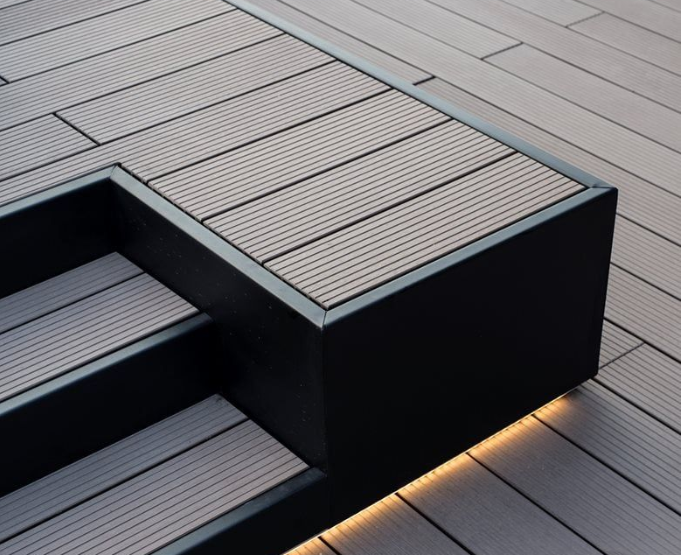
Conclusion: Let Your Deck Reflect Your Lifestyle
A well-designed deck is more than just an outdoor floor, it’s an extension of your home and your lifestyle. Whether you want a peaceful reading nook, a space for weekend BBQs, or a stylish garden retreat, the right decking design can help bring that vision to life.
With KR WPC, customization is easy and versatile. You can choose from a wide range of colors, finishes, and board styles that suit your taste and environment, whether it’s for a compact city balcony, a large backyard, or a rooftop terrace.
Features like built-in seating, planters, lighting, and privacy elements can be seamlessly integrated to match your lifestyle and the way you use your space.
Most importantly, investing in WPC decking means you’re building for the future. Its durability, water resistance, and low maintenance requirements make it a smart choice that continues to perform and look great year after year.
FAQ
What are the best decking ideas for small gardens?
For small gardens, consider built-in seating, vertical planters, or multi-level WPC decking. These designs help maximize space while keeping the area organized and stylish.
How can I make my garden decking more functional?
Add features like integrated benches, under-seat storage, shade structures, or lighting. These upgrades enhance comfort and usability without taking up extra room.
Is WPC decking suitable for a raised platform?
Yes, WPC decking is ideal for raised platforms when properly supported by a strong substructure. It resists moisture and won’t warp, making it safe and durable for elevated designs.
Can I use WPC decking around a pool?
Absolutely. WPC decking is water-resistant, slip-resistant, and won’t crack or rot, making it a great choice for poolside areas or hot tubs.
Can I mix materials like WPC and stone in one deck?
Yes, combining WPC with materials like stone, tile, or glass can create contrast and visual interest. It’s a popular design choice for modern, custom outdoor spaces.

